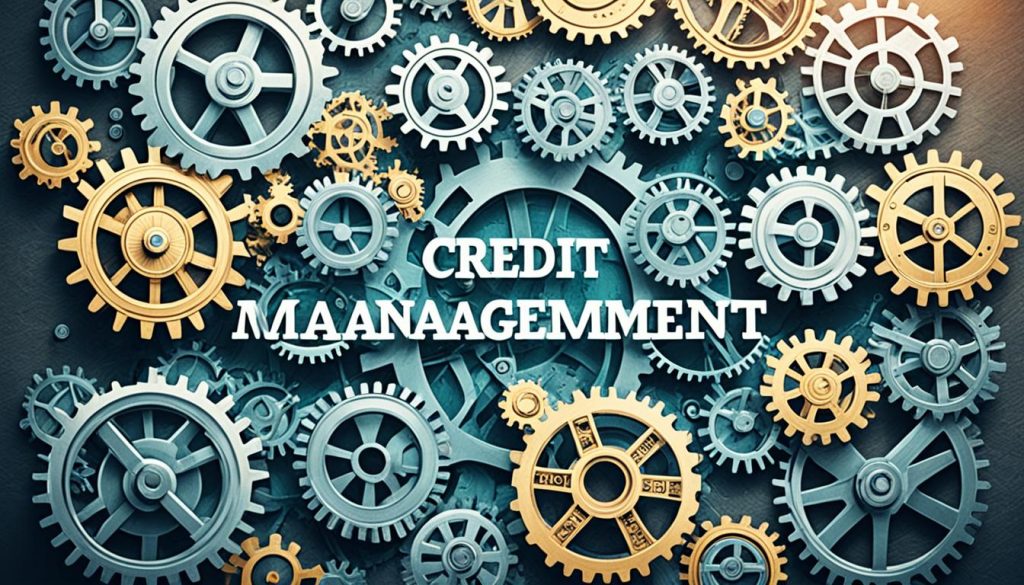In today’s complex financial world, credit risk is a big worry for banks and other financial groups. Having strong1 credit risk governance is key to keeping these institutions safe and stable. A solid framework for managing credit risk not only helps in handling risks well but also meets legal standards and builds trust with everyone involved2.
Good credit risk governance means setting up a detailed plan for managing risks. This plan should have clear rules for the board and top management, clear roles, and strict rules for credit risk. It should also have a way to rate credit risks, set limits, and watch for too much risk in one area1.
Key Takeaways
- Robust credit risk governance is essential for safeguarding financial health and stability
- Comprehensive risk management framework includes oversight, policies, procedures, and risk appetite
- Key components of credit risk governance involve underwriting, risk rating, limits, and concentration
- Building a strong risk culture is crucial for effective credit risk management
- Tailored credit risk frameworks are vital for industry-specific compliance and risk management
- https://tunekong.com/indoor-plants-101-the-best-green-companions-for-a-fresh-vibrant-home-11/
Understanding Credit Risk Governance
Credit risk governance is about the rules and systems that banks use to handle credit risk3. It helps manage credit risk and makes sure the right risk management steps are taken. Knowing the main parts of credit risk governance is key for good risk management.
Key Components of Credit Risk Governance
The main parts of credit risk governance include:
- Board and senior management oversight: Making sure the board and top management know their roles in managing credit risk3.
- Comprehensive credit risk policies and procedures: Having detailed rules and steps for managing credit risk, including how to start credit processes and who makes the decisions3.
- Well-defined risk appetite framework: Setting clear limits and guidelines for managing risk3.
- Three Lines of Defense Framework: Splitting risk management into three parts: business owners, oversight, and independent checks3.
These parts work together to make a strong system for managing credit risk in the organization3.
Most failures in risk management come from risks building up over time, not just one mistake3. Managing credit risk well means looking at the whole process, working together, and always checking and changing credit operations3.
Good credit risk management rules should be clear, short, and easy to follow3. It’s important to share and keep these rules up to date, with the chief risk officer or someone like them in charge3.
“Measuring, controlling, and limiting counterparty credit risk should be done using a wide variety of complementary metrics.”4
Creating a strong system for managing counterparty credit risk is key. It needs clear rules, limits, and ways to escalate issues, with good reports used in making decisions4.
| Key Practices in Credit Risk Governance | Description |
|---|---|
| Comprehensive due diligence | Doing a deep check on companies at the start and regularly4. |
| Credit risk mitigation strategy | Creating strong contracts and managing risks with margining4. |
| Complementary risk metrics | Using different measures to check and keep an eye on counterparty credit risk4. |
Credit risk is the base for good credit management and debt collection5. Managing credit risk well is key to avoiding big financial losses5. To reduce credit risk, it’s important to know your risk limits, check credit carefully, diversify customers, set clear payment terms, and watch the credit risk of your customers5.
Assessing credit risk is different for B2C and B2B, with different ways to check credit worthiness in each5. Giving credit to customers can have benefits but also risks of not getting paid, showing why good credit risk management is crucial5.
By understanding credit risk governance, banks can make and use effective strategies to handle credit risk. This helps ensure the financial health and success of the organization.
Credit Risk Policy and Procedures
Having a solid credit risk policy and procedures is key to managing credit risk well6. Loans and other off-balance sheet items like letters of credit add to the risk6. Credit derivatives and cash management services also bring in risk6.
Your policy should clearly state how to handle credit underwriting, risk ratings, and limits7. These steps help you keep an eye on and control credit risk to get the best return8. It’s important to keep credit risk in check, as poor risk management can lead to bank troubles worldwide8.
Creating a strong credit risk policy means looking at how you originate loans, manage your portfolio, and handle loan loss reserves7. Your policy should fit your specific needs and change as the market and your business do7.

With a detailed credit risk policy and procedures, you can manage credit risk well, protect your finances, and improve your return8. The Federal Reserve offers guidance on managing credit risk through SR 11-14, SR 21-19, and SR 20-14/CA 20-86.
Building a Strong Risk Culture
Creating a solid risk culture is key to good credit risk management. It makes sure risk management is a big part of the company’s culture. All employees know and play a part in managing credit risk9. Leaders focus on leadership, structure, policies, procedures, and people9.
Elements of a Strong Risk Culture
The base of a strong risk culture comes from the top10. What senior management does affects the credit culture9. Rewards tied to managing credit risk help in better checking out prospects and better loan quality9.
Knowing about risk and training are important9. Using technology to handle credit risk makes things more efficient9. Training, like online courses and tests, is a good way to improve credit analysis skills9. Companies that focus on credit risk have clear rules and get input from top leaders on risk and credit9.
Good communication is a big part of a strong risk culture10. Improvements are needed in aligning KPIs with risk appetite, and in how bonuses and penalties work1011. Including risk culture metrics in regular reports to the board and management is important11.
By focusing on these areas, companies can make risk management a team effort and a key part of making decisions9. Companies with strong credit cultures make sure to train their staff for better credit risk management9.

“A well-developed risk appetite framework, supported by effective processes, is essential for a sound risk culture.”10
credit risk governance
Effective credit risk governance is key for financial institutions to manage risks well. By setting credit risk appetite, using risk-adjusted pricing, and doing stress testing and scenario analysis, institutions can meet their goals and follow the law12.
The European Central Bank (ECB) looked into how 23 institutions handle counterparty credit risk (CCR) in derivatives and securities financing13. This review was about prime brokerage services, a high-risk area. The ECB set new rules for this sector after Archegos Capital Management failed12.
The Basel Committee on Banking Supervision (BCBS) has always stressed the importance of clear risk tolerance and assessments for CCR12. After the global financial crisis, they made the Basel framework stricter to deal with CCR, leverage, and liquidity risks12.
The Financial Stability Board (FSB) pointed out the growing CCR risks in commodities markets13. They said there’s a big risk because of market events and how companies are connected12. Institutions need to do more than just follow the rules. They should design risk management that fits their size, complexity, and who they work with12.

By following these best practices in credit risk governance, financial institutions can handle the changing credit risk landscape better. This helps them make smart decisions and stay strong for the long term12.
Conclusion
Creating a strong credit risk governance framework is key for financial institutions. It helps them deal with the complex and changing financial world. By using credit risk governance best practices, like setting clear credit risk policies and procedures14, building a strong risk culture15, and using data and analytics16, they can spot, measure, watch, and manage credit risk14.
Having a full credit risk governance plan does more than just protect the institution’s financial health. It also makes sure they follow the law and builds trust with everyone involved15. By keeping up with new risk management best practices, financial institutions can handle the challenges of new fintech, global connections, and economic ups and downs1416.
A solid credit risk governance framework lets financial institutions make smart choices, reduce risks, and grow sustainably in the changing financial world141516.
FAQ
What is credit risk governance?
Credit risk governance is about setting up rules and systems for banks to handle credit risk. It helps manage risks by making sure the right practices are followed.
What are the key components of credit risk governance?
Important parts of credit risk governance include top-level oversight and clear roles. It also includes detailed policies and a risk appetite framework.
What are the essential elements of credit risk policies and procedures?
Key elements include underwriting standards, rating methods, and risk limits. These help keep credit risk under control.
What are the elements of a strong risk culture?
A strong risk culture has a clear tone from the top, risk training, and aligned incentives. It also needs good communication. This makes risk management a part of the bank’s culture.
What are the essential components of a robust credit risk governance framework?
A strong framework includes setting credit risk limits and using risk-based pricing. It also involves stress testing and managing credit portfolios well. These steps help banks manage risk and meet legal standards.
Source Links
- Building a Robust Credit Risk Governance Framework – FasterCapital
- How to Build a Credit Risk Management Framework For Banks, Credit Unions
- Governance | AnalystPrep – FRM Part II Study Notes
- BCBS consults on guidelines for counterparty credit risk management
- Understanding Credit Risk
- The Fed – Supervisory Policy and Guidance Topics
- A Credit Risk Policy?
- Principles for the Management of Credit Risk
- Strong risk culture — sound banks
- Sound practices in counterparty credit risk governance and management
- Sound practices in Counterparty Credit Risk governance and management
- Credit Risk Management Process, Best Practices & Techniques In Banks
- Credit Risk Management: Challenges and Best Practices
- Credit Risk Management Explained!📈💰

